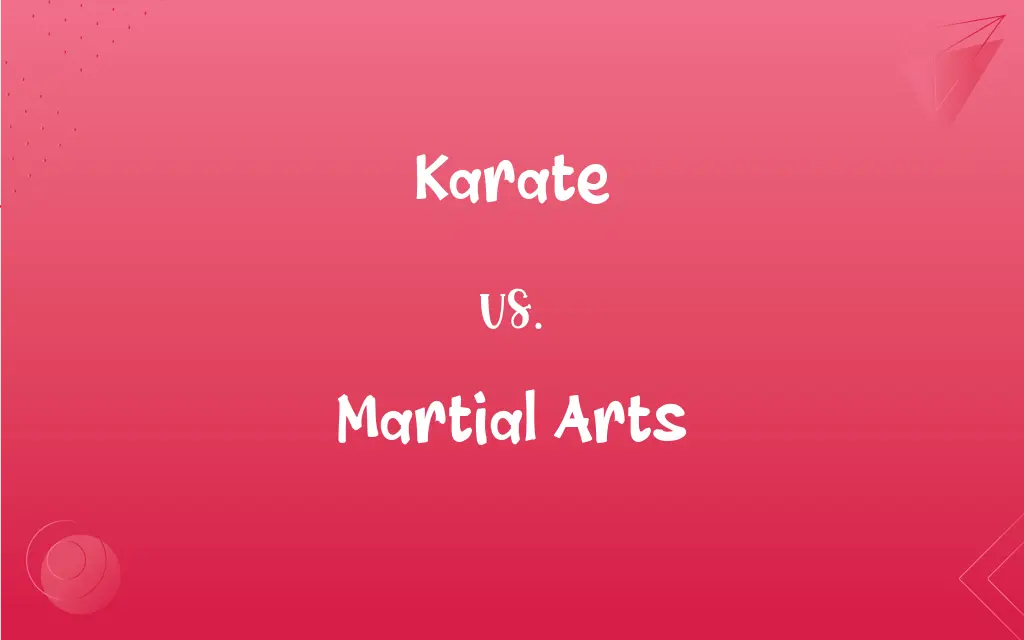Karate vs. Martial Arts: What's the Difference?
By Janet White || Published on January 1, 2024
Karate is a Japanese martial art focusing on striking, kicking, and defensive blocking with arms and legs. Martial Arts are various forms of combat and self-defense, including karate, judo, and kung fu.

Key Differences
Karate is a specific style of martial arts originating from Japan, known for its emphasis on striking techniques, such as punches and kicks. It involves specific katas (forms) and kumite (sparring). Martial arts is a broader term that encompasses a wide range of fighting systems and techniques, including karate, but also judo, taekwondo, kung fu, and many others, each with its unique focus and techniques.
In karate, practitioners learn a disciplined approach to self-defense, focusing on sharp, linear movements and powerful strikes. It is both a sport and a way of life for many. Martial arts, in general, can include not only the physical aspects of fighting but also mental and spiritual development, varying greatly between different styles like aikido, which emphasizes harmony and non-resistance.
The training in karate often includes kihon (basic techniques), kata (sequences of movements), and kumite (sparring), with a strong emphasis on character development. In contrast, martial arts as a whole cover a broader spectrum of techniques, from the grappling of Brazilian jiu-jitsu to the weapon-based training of Filipino kali.
The philosophy and techniques in karate are deeply influenced by its Japanese origins, with an emphasis on discipline, respect, and self-improvement. Martial arts as a category is culturally diverse, with each art reflecting the history and philosophy of its region of origin, such as the Chinese philosophies in kung fu or the Korean influences in taekwondo.
Karate often involves a ranking system denoted by colored belts, symbolizing a practitioner's skill level and progression. While many martial arts also use belt systems, others may have different methods of denoting expertise and progression, and some traditional martial arts may not have a formal ranking system at all.
ADVERTISEMENT
Comparison Chart
Origin
Japan
Various global origins
Focus
Striking, kicking, blocking
Diverse, including striking, grappling, weaponry
Training Components
Kihon, kata, kumite
Varies widely by style
Philosophical Roots
Japanese, emphasizing discipline and self-improvement
Culturally diverse, reflecting various philosophies
Ranking System
Colored belts
Varies; belts in many styles, none in some
ADVERTISEMENT
Karate and Martial Arts Definitions
Karate
An art form that combines self-defense techniques with spiritual and physical development.
Practicing karate has enhanced her mental and physical well-being.
Martial Arts
Disciplines that include practices like judo, taekwondo, and kung fu, each with unique techniques.
The tournament featured competitors from various martial arts backgrounds.
Karate
A Japanese martial art focusing on striking and kicking techniques.
She demonstrated her skill in karate with a powerful kata.
Martial Arts
Systems and traditions of combat, whether armed or unarmed, practiced for various reasons.
Martial arts training improved his discipline and physical fitness.
Karate
A striking-based martial art known for its distinct katas and sparring sessions.
The students practiced new katas in their karate class.
Martial Arts
A broad spectrum of fighting styles, each reflecting the culture and history of its origin.
His interest in martial arts led him to explore Asian cultures.
Karate
A discipline that teaches self-defense through precise and controlled movements.
He improved his focus and strength through karate training.
Martial Arts
Various combat practices and techniques used for self-defense, sport, and physical health.
He studied different martial arts to become a well-rounded fighter.
Karate
A combat sport that emphasizes both physical prowess and mental discipline.
The karate tournament showcased remarkable athletic talent.
Martial Arts
Traditional forms of fighting that often combine physical skills with philosophical teachings.
Through martial arts, she learned more than just fighting; she learned about life.
Karate
A Japanese martial art in which sharp blows and kicks are administered to pressure-sensitive points on the body of an opponent.
Karate
An Okinawan martial art involving primarily punching and kicking, but additionally, advanced throws, arm bars, grappling and all means of fighting.
Karate
To attack (somebody or something) with karate or similar techniques.
Karate
A traditional Japanese system of unarmed combat; sharp blows and kicks are given to pressure-sensitive points on the body of the opponent.
Karate
A traditional Japanese system of unarmed combat; sharp blows and kicks are given to pressure-sensitive points on the body of the opponent
FAQs
What are martial arts?
Martial arts are various forms of combat and self-defense practices, including styles like karate, judo, and kung fu.
Do all martial arts come from Asia?
While many originated in Asia, martial arts are global and include styles from various cultures.
Is karate only about fighting?
No, karate also emphasizes discipline, character development, and mental strength.
What is karate?
Karate is a Japanese martial art focusing on striking, kicking, and blocking techniques.
Are martial arts good for children?
Yes, martial arts can teach children discipline, respect, and self-defense.
Is karate effective for self-defense?
Yes, karate provides effective self-defense techniques.
Does karate have different styles?
Yes, there are various styles of karate, each with its own techniques and philosophies.
What is the philosophy behind martial arts?
Martial arts philosophies vary, often emphasizing self-improvement, discipline, and respect.
Can karate be practiced as a sport?
Yes, karate is both a traditional martial art and a competitive sport.
Do martial arts always involve physical combat?
Most involve physical techniques, but some also focus on mental and spiritual aspects.
How long does it take to learn karate?
It varies, but achieving proficiency can take several years.
Do martial arts help with fitness?
Yes, they are excellent for improving overall physical fitness and health.
Can martial arts be therapeutic?
Yes, they can be beneficial for mental and physical health.
What does a black belt in karate signify?
A black belt in karate represents a high level of skill and knowledge in the art.
Can martial arts be a form of meditation?
Yes, some martial arts incorporate meditative practices.
Is karate suitable for all ages?
Yes, people of all ages can practice karate.
What are katas in karate?
Katas are choreographed patterns of movements practiced in karate.
Is respect an important part of martial arts?
Respect is a fundamental aspect of all martial arts disciplines.
Are weapons used in martial arts?
Some martial arts styles involve weapons, while others are unarmed.
Are there competitions in karate?
Yes, there are local, national, and international karate competitions.
About Author
Written by
Janet WhiteJanet White has been an esteemed writer and blogger for Difference Wiki. Holding a Master's degree in Science and Medical Journalism from the prestigious Boston University, she has consistently demonstrated her expertise and passion for her field. When she's not immersed in her work, Janet relishes her time exercising, delving into a good book, and cherishing moments with friends and family.































































